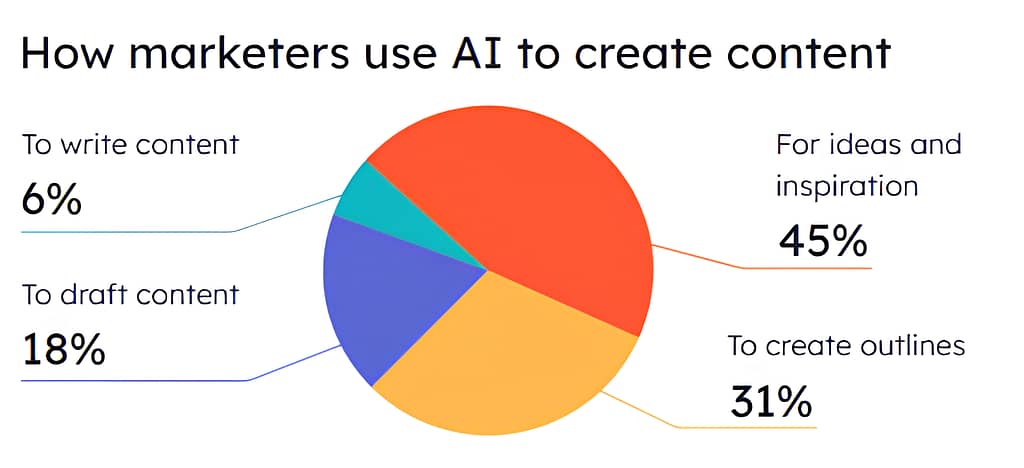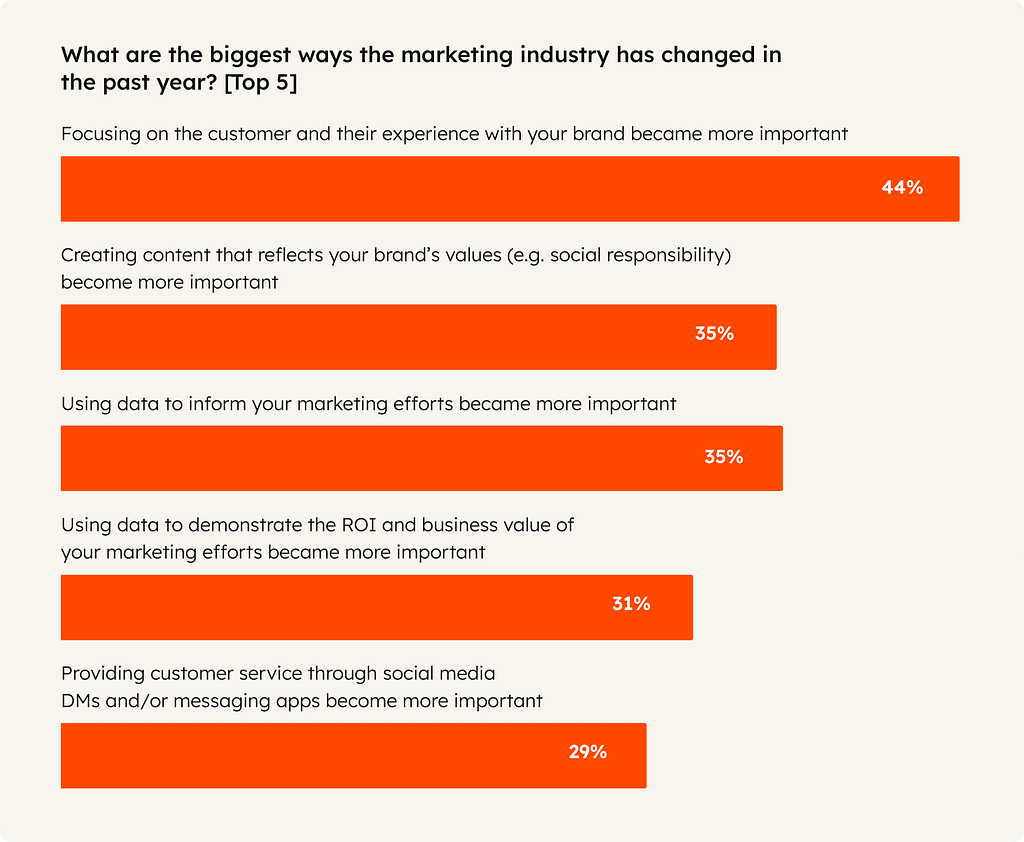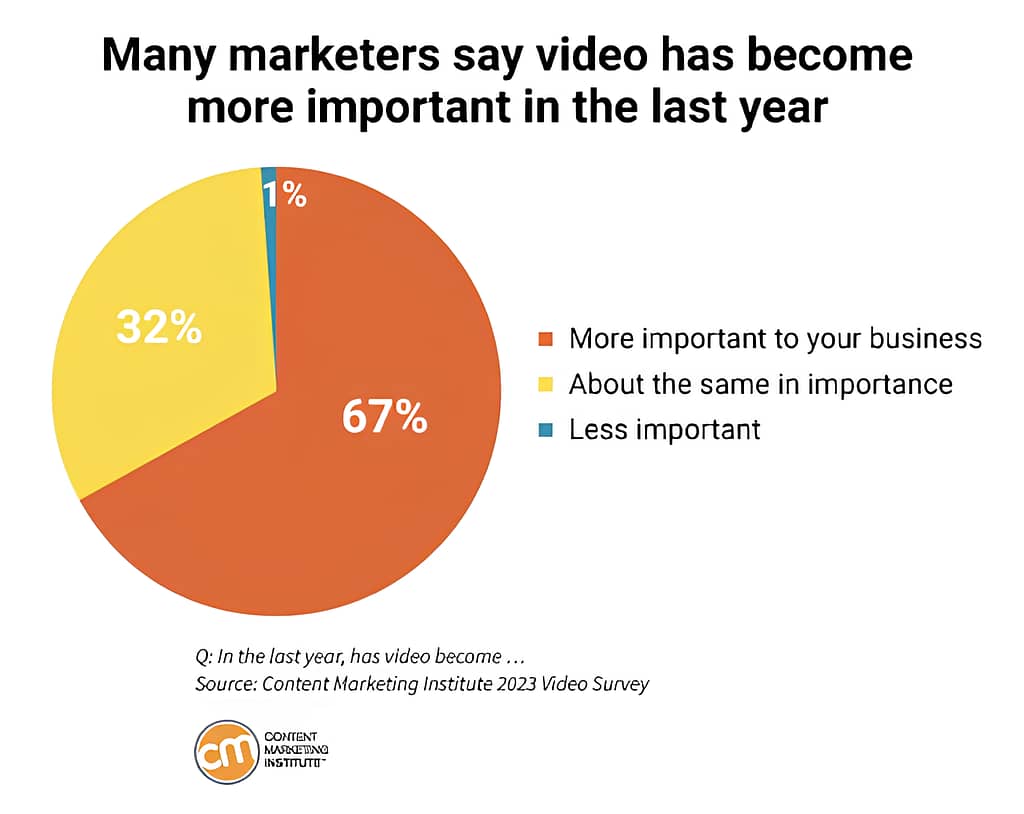Table of contents
- Key content marketing takeaways
- Introduction: The evolving landscape of content marketing in 2025
- Key content marketing trends in 2025
- 3.1 Artificial Intelligence (AI) and automation
- 3.2 Conversational and personalised content
- 3.3 Rise of attention metrics
- 3.4 Power of content repurposing
- 3.5 Continued dominance of video content
- 3.6 Importance of niche content
- 3.7 Optimising for voice search
- 3.8 Adapting to the changing search landscape
- 3.9 Leveraging user-generated content (UGC)
- 3.10 Dynamic content patterns
- 3.11 Building strong online communities
- 3.12 Quality over quantity
- 3.13 Purpose-driven content
- Conclusion: The future of content marketing
- FAQs
Key content marketing takeaways:
- Use AI to brainstorm innovative ideas or outline your next article while adding a human touch.
- Focus on attention metrics to measure how well your content is attracting visitors.
- Create content that feels personal and conversational.
- Repurpose your content to extend its lifespan and enhance its distribution.
- Use video content to engage with your audience.
- Focus on creating niche content that targets a specific audience.
- Optimise your content for voice search.
- Adapt your content marketing strategy to the changing way people search for information.
- Leverage user-generated content to gain exposure and build trust with your audience.
- Use dynamic content, including live video streams and behind-the-scenes content, to engage with your audience.
- Build a community around your brand to increase brand loyalty.
The evolving landscape of content marketing in 2025
The demand for content has reached unprecedented levels. It has become essential for businesses of all sizes to establish a strong online presence, which requires a substantial output of high-quality content. However, audience preferences are constantly evolving, making it crucial to stay informed about the latest trends in content marketing.
A study by the Content Marketing Institute reveals that 46% of B2B marketers think they’ll throw more money at their content marketing budget by 2025. They’re eyeing video stuff, with a good 61% betting that’s where the cash will flow. Plus, loads of online content just means everyone has to hustle to stand out from the crowd.
Making your content grab attention is becoming a tougher task day by day. This push sends content marketers to try all sorts of strategies – a few will fade, but some will grab hold and become key parts of a top-notch content marketing plan.

Essential content marketing trends to watch for in 2025
Feeling stuck with your content marketing efforts? Learn about the latest trends to increase leads and improve search engine rankings. Here’s a peek at popular trends to boost your content game and amp up your campaigns that rely on content.
1. Artificial Intelligence and automation
AI and robots doing our tasks aren’t new, yet 2022’s big reveal of “ChatGPT” shoved it into the spotlight for content marketing. What OpenAI made started a whole wave of innovative AI-driven tools that are tweaking how marketers approach their content strategy.
The initial and most noticeable shift in AI content marketing is about scaling content production. Regardless of their talent, a writer can make so much top-notch content. On the flip side, AI writes words way quicker yet isn’t perfect – it tends to repeat itself, it’s not original, and just rewrites what’s already out there.
You shouldn’t just trust what AI is suggesting without validating the data. The best content should have a human touch. You should bring in AI when you want to brainstorm creative ideas or create a plan for your next article. If you use it correctly, a skilled writer with AI can boost writing speed and competence to produce more good content faster.
AI boosts content marketing return on investment by analysing large amounts of data from different sources. Before AI came around, finding the right keywords and topics meant digging through loads of information from search engines, social networks, and competitors. Nowadays, a few clicks get the job done.
You could tell AI to create a content calendar with relevant content ideas and the perfect times to post for every platform. Letting AI handle this stuff means you get to put your energy and time into other important things.
Another way AI assists content creators is with SEO. It’s neat because it offers support for all SEO aspects – whether it’s on-page SEO, off-page SEO, or technical SEO. Let’s say you wanna get savvy with your article and check out the keyword density.
Artificial Intelligence is here to support you. Or maybe you’re hunting for prospects who will benefit by giving you backlinks. On the technical SEO aspect, AI is helpful with spotting and patching up technical errors like broken links or 404 errors and even has tips to improve your page loading speed.
2. Conversational and personalised content
In 2024, the trend shifted towards content that feels personal and conversational. People enjoy interacting with actual humans, not faceless companies. At the same time, they accept that chatbots and automated systems are ever present. They generally don’t mind, provided the interaction is helpful, practical, relevant, and friendly.
Source: Hubspot 2025 state of marketing report
So now, brands are catching on and trying to make their content sound more like real people talk. Want to know what this personal, conversational content is all about? Check the examples below:
- Craft content that mirrors what your audience feels requires it to be written as if it’s coming from a trusted friend or advisor.
- Encourage two-way dialogues, such as social media chats, surveys, or hosting events online that get the community involved.
- Tell stories about your team’s success stories or how they tackle customer challenges to show there are real humans behind the scenes.
- Use intelligent marketing automation to deliver personalised content to different types of customers.
The goal is to give your brand a human touch. Create a brand people see as their go-to for fixing their troubles. This vibe is crucial when creating new content or strategies in 2025.
3. Rise of attention metrics
Digital marketing professionals count on metrics such as page views and impressions to see how good a blog or webpage is doing. However, these measurements can be considered basic. Let’s say visitors click your blog and then leave quickly from that page; you’ll get more page views, but that doesn’t mean meaningful traffic or leads. A more innovative way to check how your content marketing is going is to watch if and how users interact with your content.
Different tools can give marketing professionals a hand with this:
- Heat maps show where users hang out the most on a webpage, what grabs their attention to click, and how far they scroll.
- Before visitors return to search results, the time they spend on a page is known as dwell time.
- You can peek at user behaviour through session recordings—how they get around, scroll, click, and fill out contact or survey forms on your site.
- Funnel analysis lets you see the user journey through the conversion process steps, like hitting landing pages, signing up, and completing purchases.
In the world of content marketing, we’re starting to pay more attention to something called attention metrics. Attention metrics aren’t your everyday numbers. It is all about measuring how much your target audience looks into a digital ad.
It considers factors such as how long someone looks at an ad, if they interact with it, and finally, if their engagement leads to some meaningful actions such as leads.
Traditional metrics can indicate reach, but they often fail to reflect true engagement or brand recall. While it’s nice to see those numbers, they don’t reveal whether people actually remember your ad. That’s where attention metrics come in.
They give you the information on whether your ad is attracting visitors or just goes unnoticed. This transition to focusing on attention metrics is crucial for digital marketing campaigns, as it directly influences the ROI of your content marketing initiatives.
4. The power of repurposing the content
Exceptional content remains enduring. When one possesses content that has lasting value and can be reused repeatedly, one is likely to observe significantly greater returns than materials with a limited shelf life.
The longer you promote the content, the bigger the crowd it draws, which will provide more value.
Repurposing content involves taking existing content and revitalising it by adapting and updating it for various platforms and formats.
For instance, if you wrote a comprehensive blog post on a topic that resonates with your audience and garnered significant page views and engagement, consider reusing some of the standout sections. You could transform a key quote into an X post, create a brief summary for a catchy TikTok video, or redesign it as a downloadable PDF to share with your email subscribers.
Alternatively, if you recorded an engaging podcast featuring a special guest, you could take the transcript, refine it, and publish it as a blog article.
You’ve worked to create your content, so why not make it last? Repurposing content extends its lifespan and enhances its distribution. Since people have varied habits when it comes to consuming content, repurposing is an effective strategy to connect with readers across the diverse platforms where they engage online.
Not everyone finds what they’re looking for on Google; they might stumble across your work on YouTube or spot it while browsing their top news platform. Plus, using AI tools to repurpose content is a breeze. If you’ve got old content that did well, you can give it a shot to repurpose the content.
Stay in the know
Keep on top of how the latest marketing, SEO, branding and design tips can be used to
grow your business – delivered straight to your inbox.
5. Continued dominance of video content
Sure thing, video content keeps getting more prominent as a central part of content marketing, and it’s not slowing down because folks can’t stop watching and interacting with videos. This pretty much means the growth is going insane.
A study from the CMI Video & Visual Storytelling Survey of 2023 tells us that 67% of content marketers say that video has become more crucial to their plans than before.
According to research from Wyzowl, 88% of marketers think video content marketing is vital to what they do overall. The ongoing success of video in digital marketing can be largely credited to advancements in mobile technology.
Nowadays, nearly everyone carries a powerful mini “TV” in their pockets, equipped with advanced 5G or WiFi connectivity that allows them to access data and content wherever they are.
Watching videos wherever you want was once fancy stuff, but today, it’s just the norm. With “shorts,” those engaging little videos that keep popping up, combined with our shorter-than-ever attention spans, video content marketing has become more than just a trend; it’s an essential strategy.
So, videos offer many formats for companies to play around with. As videos keep dominating as a major content marketing weapon, marketers are trying out its strengths on different platforms and exploring all sorts of video ad styles.
6. Importance of niche content
Continuing from what we saw earlier, marketers need to focus more on creating niche content. As people start using voice searches on their devices, it’s vital your content comes up with answers to their first queries and dives into more detailed follow-up information that’s super specific to the topic.
To achieve this effectively, you should strive to gain a thorough understanding of your audience’s interests and challenges.
Leverage AI solutions to collect insights on your target audience and the way their search patterns look. After that, create a plan to connect with people and boost your visibility on AI-powered search engine results pages.
But remember that despite the wide range of AI tools, audiences are still looking for a human connection. Ensure your content delivers that. When writing about high-tech content, remember to add a personal flair that simplifies ideas and makes them more relatable.
7. Optimising for voice search
Although many people still type out their search queries the old-fashioned way, there’s a decent bunch that use voice search. By 2024, around 20.5% of people had used voice search globally.
In 2024, 8.4 billion people have used voice assistants. This is a remarkable increase, nearly doubling from 4.2 billion in 2020. 2024. As AI voice assistants flood the market, it’s likely to normalise the idea of talking to our gadgets.
In 2024, 8.4 billion people have used voice assistants. This is a remarkable increase, nearly doubling from 4.2 billion in 2020.
Voice assistants like Google Assistant (also called Gemini), Siri, Alexa, and ChatGPT make life easier and come with the ability to search the web. Kids these days are getting the hang of this tech, and they are more likely to use voice search for educational purposes, entertainment, and general inquiries.
So, what’s in store for content marketers trying to make the most of voice search?
Here’s the latest voice search trends:
- Natural Language Processing (NLP): Voice assistants and search engines are getting better at grasping natural language thanks to NLP delivering more precise outcomes.
- Conversational queries: As voice search gets conversational, marketers need to prepare for more natural-sounding search terms.
- Local SEO: If you’re searching for a local business, you have to make sure your local listings are accurate and detailed.
- Content optimisation: Content should directly respond to enquiries and correspond with the type of questions individuals are likely to ask aloud.
- Device integration: You should aim to make your content accessible across different devices and platforms for a smooth experience across the board.
8. Adapting to the changing search landscape
Tech users are always grasping new gadgets. As a marketer, it’s essential to keep up with these changes and adapt swiftly. In 2024, Google rolled out generative AI search results. At the top of page one, you will find a summary of the leading results produced by AI, along with links to each source.
One content marketing trend is to provide specific answers to users’ search queries. Precision is key to effective information delivery, as AI focuses on matching search terms. This suggests that general, overarching topics may not be as effective, while more detailed and specific content will likely resonate better.
The internet will shift towards a conversational-based style for searching. This involves users posing a question on their topic, receiving some generated responses, and then asking additional questions for more details until they click a link that grabs their attention. Search tools like Perplexity.ai, Gemini, and ChatGPT, which already allow users to ask extra questions, are making this happen.
9. Leveraging user-generated content (UGC)
In this age where we are bombarded with commercial ads, UGC comes across as a refresher.
When you’re scrolling through your feeds, like on Instagram or TikTok, you can stumble on something that makes you stop dead – maybe some engaging words or a video that just hooks you right in.
A super neat piece of content? Not necessarily. The true magic lies in the authentic feel and how people can relate to it – that’s what makes user-generated content (UGC) so powerful.
The right mention of your brand or a related topic at the perfect moment, created by an everyday user instead of a brand or well-known influencer, can be incredibly effective from a marketing perspective.
It might be something as straightforward as a video of someone reviewing your product, like a live unboxing. It could also be someone casually discussing a topic connected to your offering and mentioning your brand in passing. If these posts or videos resonate with viewers, it’s a fantastic way to gain additional exposure.
The key aspect of user-generated content (UGC) is that it should feel natural. Authenticity is something that can’t be manufactured. What you want is a genuine moment that unfolds spontaneously.
If you come across a piece of UGC that feels authentic and relatable, you can engage with it by liking, commenting, and sharing from your brand account. Just be cautious not to overdo it, as the beauty of UGC lies in its organic nature.
10. Dynamic content Patterns
Dynamic, “in-the-moment” content, including live video streams and behind-the-scenes, is getting popular. People are into these because they come off as super genuine. They pull in the crowd by making them feel part of the video content.
Live content creates a feeling of urgency and a unique vibe. People tune in because it’s not happening again, and the fear of missing out is real. You find the jackpot when you serve up “can’t-miss moments” that pull people into feeling they’re part of an exclusive circle.
Live streaming also sparks chatter, like comments flying in as things unfold, giving your content a nice boost.
Getting a sneak peek at behind-the-scenes content is a big deal because it lifts the veil. Catching a glimpse of the behind-the-scenes and meeting the real people who make a brand tick gets thumbs up from people. It enhances your brand’s trustworthiness and eliminates the formality barrier that could otherwise exist.
11. Building strong online communities
Everyone uses the term “community” when they talk about marketing. And they’ve got the point. We are all social beings. People like to feel a sense of belonging where they are a part of something. If you can get people to feel that with your brand, you’ve got a better shot at them returning for more.
For instance, the fitness brand Peloton sells high-end exercise bikes. They made a whole community around their brand. People sign up for live leaderboards, team up for challenges, and celebrate together when they hit big milestones.
Members frequently share their stories and participate in virtual meetups on their app and social media, which often lead to in-person gatherings as well. This strategy transforms regular customers into brand advocates who connect with one another and develop a sense of loyalty towards the brand.
12. Quality over quantity
While AI can help scale content production, it’s crucial to remember that quality will always reign supreme.
- Focus on creating valuable, relevant, and insightful content that resonates with your target audience.
- Prioritise depth and originality over simply churning out large volumes of content.
- Ensure your content is well-researched, accurate, and engaging.
- Review and refine your content strategy to ensure it aligns with your overall business objectives.
By prioritising quality over quantity, you can easily build a robust brand reputation and establish yourself as a trusted source of information within your industry.
13. Purpose-driven content:
In an increasingly saturated digital landscape, your content needs to have a clear purpose. Simply creating content for its own sake is no longer sufficient. Define your goals: Is it to increase brand awareness, generate leads, drive conversions, or build community? Ensure every content aligns with these objectives and contributes to your overall marketing strategy. By focusing on creating purpose-driven content, you can maximise your return on investment and achieve meaningful results.
Conclusion: The future of content marketing
The future of content marketing is dynamic and exciting. Looking ahead to 2025, we’ll keep seeing popular content trends like video content marketing (short-form videos) and personalised content. We’ll also see things like AI content creation and automation.
Whether the strategies are old or crafted now, there is no pressure to use them all at once or not even at all. Stay in the loop with what’s up and what you can do. This will assist you in developing a more efficient content marketing strategy that will align with your available resources and budget.
Ready to elevate your content marketing game? Contact us today for a free consultation.
Frequently Asked Questions (FAQs)
Content marketing boosts a brand’s recognition, involvement, and loyalty by offering help and connecting with people. Great content nudges people to your site, generates new leads, and ultimately helps you make profits. In 2025, as online spaces get more crowded, the brands that forge deep ties will win.
Content marketing’s future relies heavily on personalisation and the use of advanced AI tools, such as Gemini, ChatGPT, etc,. to make things just right for each person. You will see more trends such as voice search optimisation, interactive content and immersive experiences through AR and VR.
Still, brands need to keep it real with the human touch, not just only technical. You need to target creating content that not only attracts your audience’s attention but also creates a connection with them.
The 4 pillars of content marketing are as follows:
- Strategy: Decide what you aim to achieve with your content and map out a plan to get there.
- Creation: Craft helpful and engaging content that captures your viewers’ attention.
- Distribution: Deliver your content to the right target audience using the best online platforms.
- Analysis: Take a good look at how your content is performing and harness that knowledge to boost your future output.
To measure the success of your content beyond traditional metrics, you can focus on page views and bounce rates (how quickly people leave). Focus on attention metrics such as how long they stay on the page (dwell time), how far they scroll (scroll depth), and how they interact (shares, comments, time spent on specific parts). Use tools like heatmaps and session recordings to understand user behaviour. Knowing this lets you tweak your content strategy to capture your audience’s attention.
Content marketing formats include blog posts, video clips, podcasts, infographics, email newsletters, social media updates, webinars, e-books, and whitepapers. Each form is used for different reasons and addresses various steps a customer takes, from getting to know the brand to making choices.
Google’s E-E-A-T (Expertise, Experience, Authoritativeness, Trustworthiness) is crucial for content marketing. It signals to Google that your content is reliable and valuable. To improve your E-E-A-T:
- Establish expertise: Highlight the credentials and experience of your authors.
- Demonstrate experience: Share real-world examples and case studies.
- Build authority: Cite credible sources and earn backlinks from reputable websites.
- Foster trust: Maintain transparency and build a strong brand reputation.
By prioritising E-E-A-T, you can improve your search engine rankings and build trust with your audience.
The 3 Cs in content marketing refer to:
- Circulate: Share your content on various digital channels to attract more eyeballs and spark interest.
- Create: Write brand-new, handy, and entertaining goodies.
- Curate: Dig around for existing content and share it with people who are looking for it.






